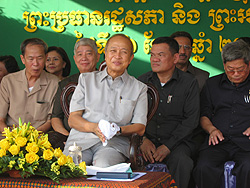
J : J.F. Kennedy!
K : Cette unité est payée par le gouvernement, autorisée par Hun Sèn mais suggérée par Nhiek Bun Chhay.
J : J.F. Kennedy!

| LES 6 COMMANDEMENTS |
COURRI@L 2004 | THE 6 COMMANDMENTS |
 |
J : J.F. Kennedy! K : Cette unité est payée par le gouvernement, autorisée par Hun Sèn mais suggérée par Nhiek Bun Chhay. J : J.F. Kennedy! |
 |
 |
J : J.F. Kennedy! L : Pourquoi dis-tu toujours Kennedy-Kennedy? J : Ben, Président J.F. Kennedy! [ PHOTOS RADIO FREE ASIA ] |
 |
Who is the prestigious "fake" Cambodian who opposes Hun Sen?
(2004-Dec-13)
Samngatki : In a December 10 interview posted on his website,
King-Father Norodom Sihanouk indirectly responded to Prime Minister Hun
Sen who had recently denounced a "prestigious fake
Cambodian" as his most virulent critic.
According to the King-Father, Hun Sen might have targeted himself (Norodom
Sihanouk), or Ruom Ritt, his childhood friend who has been expressing views
similar to his, or opposition leader Sam Rainsy. But in the King-Father's
opinion, none of the three "suspects" matches Hun Sen's accusation or description.
N.P. : Indeed, Hun Sen's most virulent critic is ... the trio "3 Martians" !

|
- 1992: 38%. - 1998: 36%. - 2004: 43%. - 2005 (est.): 45%. (Sources: World Bank, UNDP). |
- 1990: 97 / 1,000. - 2001: 138 / 1,000. - 2003: 140 / 1,000 [compared to 23 / 1,000 for Vietnam, and 5 / 1,000 for Singapore]. (Sources: UNDP "Human Development Report" 2003; Unicef "Childhood Under Threat: The State of the World's Children 2005" Report). |
- Analphabetism (no knowledge of the alphabet): 36 %. - Illiteracy (some knowledge of the alphabet but inability to read and write properly): 27%. - Total adult illiteracy rate: 63%, compared to less than 60% in 1990. (Sources: UNDP, Cambodian Ministry of Education). |
The plight of Cambodian children (2004-Dec-13)
Samngatki : - 14 percent of Cambodian babies born today will
die before reaching the age of five.
- Almost one in every 10 babies born in Cambodia does not live to their
first birthday.
- 60,000 to 65,000 Cambodian babies (less than one-year old) die every
year of malnutrition or disease that can be prevented or cured.
- 45 percent of Cambodian children are malnourished.
- 54 percent of Cambodian children suffer from stunted growth.
- 66 percent of Cambodian children do not have access to safe water.
- 2.2 million children in Cambodia live in absolute poverty.
(Sources: UNDP, Unicef).
INTERNATIONAL AID WIPED OUT BY CORRUPTION (2004-Dec-07)
Sam Rainsy, Member of Parliament : The cost of corruption for
Cambodia can be divided into 3 parts – mismanagement of the National Budget,
loss of revenue from mismanagement of State assets, and social and environmental
costs to the nation.
I - Mismanagement of the National Budget A - Loss of Tax Revenue - According to a recent report by the US Aid, Cambodian Corruption Assessment, “annual diversions from government coffers range between $300 and $500 million.” A World Bank-sponsored document in 2003, Draft for Decision-Making – Towards a Private Sector Development Strategy for Cambodia – Investment Climate Assessment, indicates, “using the average of 5.2% of sales paid in the form of bribes in manufacturing and services and multiplying this by the sectors' contribution to GDP, a rough estimate of bribe payments for these sectors amounts to around $120 million.” |
 |
II – Loss of Revenue from Mismanagement of State
Assets
The main State assets are made up of land, forests, rubber plantations,
fishing lots, airspace (civil aviation), and airwaves (telecommunication).
Only a small portion of revenues from the management in the form of sale,
lease, rent, concessions of State assets are paid into the National Budget
under the heading, "Non-Tax Revenue"; the bulk of the revenues is collected
by the main ruling party and government officials. The Non-Tax Revenue
disclosed only $128 million in 2003. Various Global Witness reports indicate
that the value of at least 300 million cubic meters of timber fraudulently
exported from Cambodia since 1994 can be conservatively estimated at $3
billion or $250 million a year. According to an “Independent Review of
the Forestry Sector” written by a group of international experts representing
donor countries and given to the Cambodian government in April 2004, any
commune with 5,000 hectares of well-managed forest could annually collect
– in a sustainable manner – $150,000 for local communities. As 6
million hectares have been lost to forest concessions, the nation,
in effect, forgoes annual revenue of $180 million, which would go a long
way for rural Cambodia, especially for poor villagers in remote areas.
A report entitled, “Feast or Famine - A Report Documenting Conflicts and
Abuses of Vital Fishing Grounds in Cambodia” published in 2003 by the Cambodia-based
Fishery Action Coalition Team (FACT) in collaboration with the London-based
Environmental Justice Foundation, claims that “inland
fisheries produce an estimated 200,000-400,000 tons of fish each year with
an estimated value of up to $500 million. Only a tiny fraction of these
funds reaches Government.” A tax of 5% of the value of fish
catches would bring in $25 million to the State coffers; in 2003, revenue
from fishery amounts to only $1.5 million. Therefore, the mismanagement
of forest and fishery alone causes a loss of revenue of over $200 million
a year. Many items concerning land, rubber plantations, civil aviation,
telecommunication, which are also sources of corruption, have not been
accounted for in the above calculation.
III - Social and environmental costs
Over the last ten years, main engines of economic growth for Cambodia have
been prostitution, gambling, drug trafficking,
and illegal logging. These industries have brought about social
and environmental costs associated with the effects of HIV/Aids linked
to human trafficking, the destruction of the social fabric, the increase
in violence due to gambling and drug trafficking, and ecological disasters
such as floods and droughts caused by deforestation. These social and environmental
costs are being translated into economic costs (medical expenditures, loss
of work productivity, crop destruction, damage to infrastructure caused
by floods, etc.) that are difficult to assess, but are definitely an increasing
financial burden for the nation.
IV - Conclusion
The total cost of corruption in Cambodia
– at least $ 800 million – has far
exceeded the amount of foreign aid of approximately $600 million a year
up to 2004, and $504 million for 2005. It has virtually wiped out the anticipated
benefit of the international assistance in terms of poverty reduction.
| LES SIX COMMANDEMENTS | REFORMING OUR BUDDHISM | ROMAN POLITIQUE | KHMER GRAMMAR | COURRI@L 2004 (Previous) |
| CAMBODIATRIBE |
PHN@M-P@NH-P@TINS |
FRAN-GLO-GIBWÉ |
DIEU vs BOUDDHA |